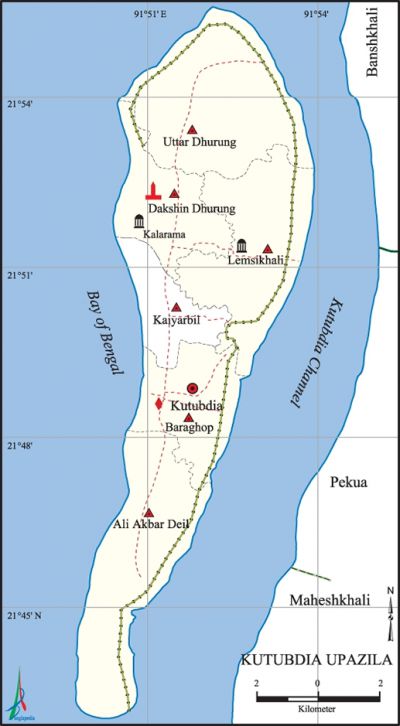Kutubdia Upazila
Kutubdia Upazila (cox's Bazar district) area 215.8 sq km, located in between 21°43' and 21°56' north latitudes and in between 91°50' and 91°54' east longitudes. It is bounded by the bay of bengal on the north, west and south, Kutubdia Channel, banshkhali, pekua and maheshkhali upazilas on the east.
Population Total 107221; male 55848, female 51373; Muslim 99714, Hindu 7460, Buddhist 10, Christian 24 and others 13.
Water bodies bay of bengal,' Kutubdia Channel are notable.
Administration Kutubdia Thana was formed in 1917 and it was turned into an upazila on 1983.
| Upazila | ||||||||
| Municipality | Union | Mouza | Village | Population | Density (per sq km) | Literacy rate (%) | ||
| Urban | Rural | Urban | Rural | |||||
|
- |
6 |
9 |
30 |
22024 |
85197 |
494 |
38.02 |
25.80 |
| Upazila Town | ||||||||
|
Area (sq km) |
Mouza |
Population |
Density |
Literacy rate | ||||
|
9.96 |
1 |
22024 |
2211 |
38.02 | ||||
| Union | ||||
| Name of union and GO code | Area (acre) | Population | Literacy rate (%) | |
| Male | Female | |||
|
Ali Akbar Deil 13 |
4546 |
10652 |
9491 |
22.61 |
|
Uttar Dhurung 81 |
4816 |
11792 |
10672 |
21.99 |
|
Kaiyarbil 54 |
1585 |
5802 |
5603 |
25.69 |
|
Dakshin Dhurung 40 |
2498 |
7432 |
7179 |
27.37 |
|
Baraghop 27 |
2470 |
11395 |
10629 |
38.02 |
|
Lemsikhali 67 |
3997 |
8775 |
7799 |
33.68 |
Source Bangladesh Population Census 2001, Bangladesh Bureau of Statistics
Archaeological heritage and relics Kutubdia Bati Ghar (light house) at Dakshin Dhurang, Kalarma Mosque, tomb of Kutub Aulia.
Marks of the War of Liberation Memorial monument 1 (ghatkul Para).
Religious institutions Ek Hatia Fakirer Mosque, Kalarma Mosque, Maharaja Kazir Mosque, Tomb of Kutub Aulia.

Literacy rate and educational institutions Average literacy 28.4%; male 32.7%, female 23.7%. Noted educational institutions: Kutubdia High School (1938), Durung High School (1948).
Newspapers and periodicals Daily: Darpan (1986), Balichar (1983), Kutubdia Barta (1993).
Cultural organisations Library 1, press club 1.
Tourists spots Kutubdia Bati Ghar.
Main sources of income Agriculture 63.27%, non-agricultural labourer 6.23%, commerce 13.13%, transport and communication 1.31%, service 4.47%, construction 0.69%, religious service 0.27%, rent and remittance 0.23% and others 10.40%.
Ownership of agricultural land Landowner 44.02%, landless 55.98%; agricultural landowner: urban 43.90% and rural 44.05%.
Main crops Paddy, potato.
Extinct or nearly extinct crops Kaun.
Main fruits Mango, banana, papaya, plum, watermelon, coconut, betel nut.
Fisheries, dairies and poultries Shrimp project.
Extinct or nearly extinct traditional transport Palanquin, horse carriage, bullock cart.
Noted manufactories Rice mill, saw mill, salt mill, ice factory, welding factory.
Cottage industries Goldsmith, blacksmith, bamboo work.
Hats, bazars and fairs Hats and bazars are 12, most noted of which are Bara Ghop Bazar, Dhurung Bazar.
Main exports Fish, salt.
Access to electricity All the unions of the upazila are under rural electrification net-work. However 2.96% of the dwelling households have access to electricity.
Natural resources Natural gas, sulphur, ceramic clay, black sand.
Sources of drinking water Tube-well 91.07%, tap 1.86%, pond 4.18% and others 2.89%.
Sanitation 35.58% (rural 30.82% and urban 54%) of dwelling households of the upazila use sanitary latrines and 53.65% (rural 58.80% and urban 33.70%) of dwelling households use non-sanitary latrines; 10.78% of households do not have latrine facilities.
Health centres Upazila health complex 1, satellite clinic 4, family planning centre 6.
Natural disasters Due to geographical location Kutubdia is a natural disaster prone area. A huge number of people were victims of the tidal bore of 1569, earthquake of 1762, tornado of 1795, Mahapralaya (tsunami) of 1872, tidal bore of 1897 (it is popularly known as 'Maghir Tufan' or cyclone held in the month of Magh, BS), tornado of 1905, tidal bores of 1960, 1970 and 1991, etc. Besides, these natural disasters also caused heavy damages to settlements, livestock and crops of the upazila. About 10000 people were victims of the tidal bore on 29 April 1991; during this event, a large part of the upazila was submerged in the Bay of Bengal.'
NGO activities Operationally important NGO is brac. [Md Wajed Ali Kutubi]
References Bangladesh Population Census 2001, Bangladesh Bureau of Statistics; Cultural survey report of Kutubdia Upazila 2007.
